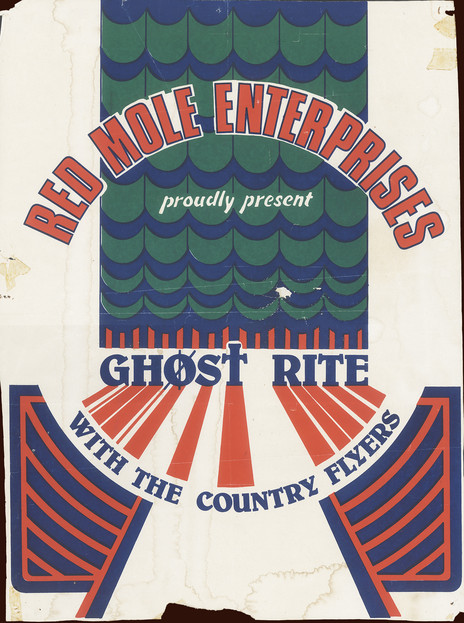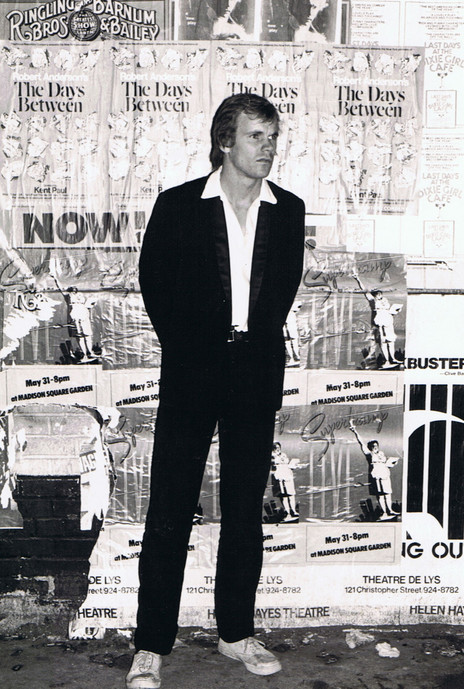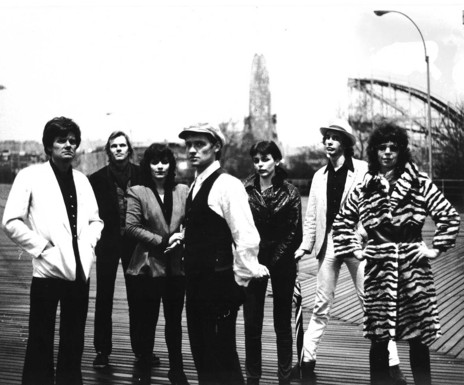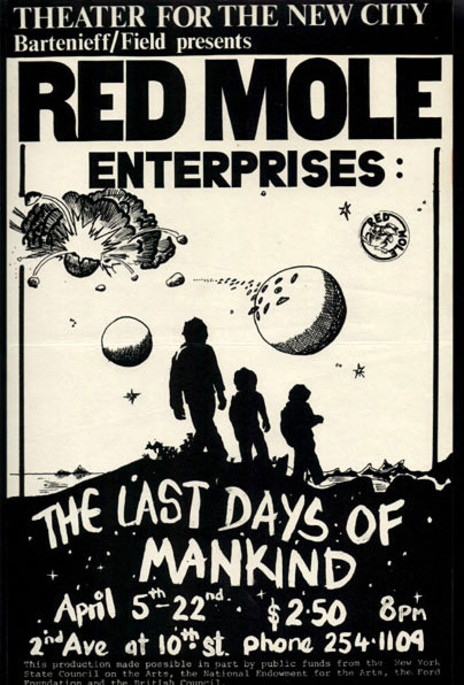In 1979, after playing in Midge Marsden’s Country Flyers, bass player Neil Hannan travelled to New York to back the Red Mole troupe. A two-year odyssey followed in which he performed with them in the United States and England.
--
Wellington.
My Red Mole journey began early 1977, at the bar of Wellington’s Carmen’s Balcony after a Cabaret Capital Strut performance. Casually meeting them at the bar was to have epic consequences for me. Later, Sally’s and Deborah’s dance performances at a New York City clip joint on 46th St, while Alan toiled relentlessly at scripts on the 11th floor of the Consulate Hotel, put paid to any real meaning regarding what was going on: survival was the name of the game.

Neil Hannan with The Country Flyers, 1976
While never wanting to sell out or compromise their performances in any way, the Moles had decided to take up my offer to add rock, roots and Middle-Eastern music to their shows, and so a solid six-month period of “commercial” success began. It was always about the show, and Alan Brunton’s prodigious writing saw to it that there was always a show to be worked on. And so there was, for a while, a sense of commitment to each other – apart from venal commentary regarding the rest of the cast heard though dressing room walls. Were we supposed to hear it? Or was it just Alan’s witty repartee to keep his present company docile and amused, and no one else in the way of the ménage à trois.
Auckland.
Later in 1977 the Country Flyers moved to Auckland – the Moles moved too – en route to the world. (I’d first left Wellington seven years earlier, working a trip with a band to England on the Northern Star – a rite of passage for many a young musician in the 60s and 70s). The Flyers worked the late-night Mole shows at the Ace of Clubs in Auckland City. One night, as we were running out of the Windsor Castle to start the Moles gig next door at the Sweet Factory in Parnell, band leader Midge [Midge Marsden] got arrested and locked up for the night. Late on child support – those were the days.

Poster for the Red Mole production Ghost Rite, with The Country Flyers and Neville Purvis, 1978.
After all the cabaret, Red Mole longed to create bigger and more complex theatre. “Someday, all theatre will be like this” became their moniker for a new era of work, and Ghost Rite began a series of big shows that took to the road.
New York.
The Red Mole Troupe travelled to the US in late 1978. I joined them in NYC early 1979. We were all ensconced in the Consulate Hotel on 49th and Broadway: the heart of the Theatre District. The Moles were strictly “Off Off Broadway”, however. They were already performing The Last Days of Mankind at the Theatre for the New City in the East Village when I arrived, with music by Red Alert, led by Jan Preston.

Neil Hannan in New York City, 1979
There were soon to be ructions and upheavals. At the end of their season of The Last Days of Mankind it was decided to take the show to England. This required a culling of personnel as some could no longer work together. Guitarist Richard Kennedy, Jan and I took on the mantle of the Red Mole Orchestra, and would make the trip to the UK with them. The rest of the Red Alert Band, Stan, Jean and Tony, would stay in NYC to make an art out of street-performing as The Drongos.
Elephant & Castle, London.
We landed at Intergalactic Art, an old pub in the Elephant & Castle, converted piecemeal into a dance studio, rehearsal space, recording studio, workshop and accommodation. The place was run by Roland, who seemed to be the brains, and Steve, a black Liverpudlian, who seemed to be the rent collector. Alan decided the place was really a squat and wondered why we’d pay rent.
Alan’s tongue, his weapon of choice, got Steve riled; he knew he was being insulted, didn’t know how but he knew he was, so he went upstairs, put on his steel capped boots, stuck a blade in his back pocket and came back down to confront the smart-arse Brunton.
Luckily, the Moles had found a real squat and were able to announce they were leaving before Alan “got his”. I stayed and fell in with Josh McCauley, an Irish dealer, and a regular at the Intergalactic Art rehearsal space. He’d pay me in product for various services and rentals, and once lent me his little Alfa convertible to check out a potential venue down the Old Kent Road. Steve came along for the ride; sure made him feel good: cruising the Southeast waving at the plebs.
Hackney. Guildford. Sheffield.
The UK version of The Last Days of Mankind was worked up at the Mole’s Hackney squat. The story went something like:
In the street a group of actors struggling for a living is struggling for an audience. They are located in a country where the hard rain is always just about to fall. They have the vaudevillian air of some day long ago. They are LORD GALAXY’S TRAVELLING PLAYERS, definitely about to sing and dance with a touch of Days of Heaven, from the show of the same name. They are a touring troupe presenting the preamble to the revolution for the village meeting of recently liberated peoples. The discussion is about the legitimacy of the new regime and the injustices of the old. Eventually the film ends ... and it is about to rain again. Only this time a Hard Rain, A White Rain, a reign of Heavy Water. Heavy like Shah Pahlavi. We end with a song of joy and optimism.
A drummer was required for this production and for Red Mole Orchestra’s extramural gigs. A boy from Leeds, Chris Whitten, agreed to come along for the ride, unfazed by the organised chaos. Inspired, Chris’s career after Red Mole spiralled through Julian Cope, Waterboys, Dire Straits and Paul McCartney. Mole performances at this time were staged at the famous Crucible Theatre in Sheffield, the Surrey Free Arts Festival in Guildford and Oval House London. The more raunchy production Blood on the Tracks was performed in The Crypt at Covent Garden. The topless fire-eating seemed to get things going. Tribal London was never more in evidence the night we played the Albany Empire in Deptford. I’d never seen such extreme violence or so much blood, when a group from outside the “territory” dared venture into the club. A more enjoyable gig around this time was at London’s NZ Rugby Club, where Chris and I jammed with Michael (“Mr Ears can play anything”) Houston.
New York. Philadelphia.
We returned to New York in October 1979 to prepare for the Numbered Days in Paradise Tour USA. The show Dead Fingers Walk was already worked up however, and enjoyed another successful season at the Theatre for the New City. In a city where no one has time to investigate everything for themselves, the Village Voice critic Erika Monk ensured full houses with her commentary: “Red Mole’s people are sexy flesh and blood. Their work, however macabre or hysterical in the moment, is backed with a feeling of happiness and activism, though they live in and show our culture as it is: not the easiest maneuver, all things considered. Most effective social satire has a meaner edge. But not a sharper one.”

The Red Mole Troupe, Coney Island. New York, October 1979. From left: Alan Brunton, Neil Hannan, Deborah Hunt, John Davies, Jan Preston, Martin Edmond, Sally Rodwell. - Photo by Joe Bleakley
Our band on the side was now called The Shaky Islanders, a band infinitely more promising than its name, said Time Out. We played all the hot spots; the money didn’t flow like wine, but we worked CBGB, Max’s Kansas City, The Mudd Club and my favourite, The Hot Club in Philadelphia, a room where the presence of Iggy Pop from the night before was still palpable. I met Debra – the perfect barfly – fell in love for a few weeks. She came back to NYC with me after coming to other gigs in Philly. She was beautiful, dreamy and had lots of drugs. We parted on the subway with a kiss, and she said: “You don’t want an old chick like me hanging round.” She was 26.
Drummer Chris had advertised his skills around NYC, and soon started hanging with the Blondie scene, at one point auditioning for James Chance and the Contortions. So, at the end of our series of gigs on the eastern seaboard, more ructions occurred in the troupe, and the band disintegrated. Jan and I were now the Red Mole Orchestra and we hit the road to look for America. Ha.
Baltimore. Washington. Knoxville.
Our gigs at the Maryland Institute College of Art were sensational, if unattended: it was good practice for the forthcoming work. Everyone around us in Baltimore – the city made painfully sad in the Randy Newman song –
Drunk lyin’ on the sidewalk, Sleepin’ in the rain
And they hide their faces, And they hide their eyes ...
’Cause the city’s dyin’
And they don’t know why
Oh, Baltimore, man it’s hard just to live
– was generous and kind.
We moved on to Washington DC. Did a gig at the New Zealand Embassy, followed by a stay at the New Zealand deputy-ambassador’s residence at a prestigious address: the best stocked wine cellar-booze-hospitality-foreign-dignatory-ra-ra. That night, the deputy-ambassador was watching Steinlager win a best beer competition: we shared in the unlimited stocks.
We drove out of Washington in a 1969 Pontiac LeMans wagon (car and plates purchased in a Puerto Rican hood of NYC – which would cause a few probs later in the trip). Packed to the gunnels. Two wheel-bearing blow-outs – one just before Richmond, Virginia on a Sunday night. Found an after-hours garage, where the “southern” mechanic didn’t say one word to us, but fixed the car. The band drove on, with the opposite bearing smoking as we approached Knoxville, Tennessee.
The Red Moles sailed past us stopped on the side of Interstate 81, in their 1970 Buick LeSabre. The mentality was “look after yourself” – but actually, I think they did back up and offer a few bucks for the repairs.
Birmingham, Alabama.
Got off Interstate 59 at Birmingham, Alabama. The race riots of 1963 seemed a not-too-distant memory when we stumbled into a classic southern black barbershop, looking to use the bathroom. Hostility at first – what’s honky doing here – but we were soon forgiven. Driving that evening somewhere south of Tuscaloosa, we were pulled over by the local highway patrol: they’d run our New York plates. The cops approached, hands on guns: License and rego. “License in my luggage, sir ...” Was allowed to get out and look for it. Your plates belong to a 1967 Ford Galaxie ... “Oh really, we just bought what came with the car.” Where are you headed? “New Orleans.” Okay, just get out of our state.
So we did. Crossed into Mississippi, where there was an actual border station manned by armed police. Where are you headed? “New Orleans, just passing through.” Okay, go don’t linger in our state.

Red Mole - The Last Days of Mankind, New York. - Red Mole archive/new zealand electronic poetry centre
New Orleans. San Antonio.
The Muso-Lighting section of the Red Mole troupe arrived in New Orleans. Our hosts were more interested in giving Jan a good time, and would have preferred to get rid of her humdrum associates so they could show her the real “Noo Aw-linz”. But the Noo Awlinz boys couldn’t quite get it together to have a crack, and so we all ended up down in the French Quarter. Bourbon Street was touristy then, but we certainly enjoyed some fine R&B.
In San Antonio our Mexican hosts wasted no time telling us who really owned the place. Texas has a very similar history to New Zealand in the respect that the so-called gringo colonisers were initially invited in by the extant natives, but took it upon themselves to decide it was their manifest destiny to take over completely. Anyway, we performed for the Mexican American Unity Council.
Austin. El Paso.
Seventy miles up the road was one of the best gigs of the entire tour. Esther’s Pool on 6th Street in Austin was a venue made for the type of theatre that Red Mole excelled at, and for this night we revived the political cabaret from Carmen’s Balcony days. The stage at Esther’s had been built adjacent to the window facing the street, which was highly effective for advertising your presence. Back in 1979, 6th Street was a low-rent, seamy part of town, so nowadays it’s claimed that Esther’s was a significant factor in the development of Austin’s entertainment district.
This was the time of the Iranian hostage crisis at the American Embassy in Tehran. A hysterical Christian fundamentalist (scary) anti-Iranian demonstration marched through the streets of Austin. We left for Albuquerque via the slightly longer route through El Paso, stopping there for the night beside the Rio Grande. The river was reduced to a trickle at that time of year and we were entertained by the sight of “wetbacks” crossing unimpeded between Mexico and the US, and vice versa. Border control was a different concept back then.
Albuquerque.
Met Lori at the University of New Mexico during a lunchtime campus concert: she made a beeline for me, and then her dad dropped her off at our gig that night at Central Café Torta in downtown Albuquerque. The Moles had a field day with jokes about adolescent infatuation: this sort of occurrence often appeared in a script that night. She was a part-time waitress at a family restaurant. She said “Come along – I’ll get you all a free meal.” Poor girl regretted that.
Numbered Days in Paradise played at The KiMo Theatre, a beautiful 1927 Pueblo Deco style building saved from demolition by the citizens of Albuquerque in 1977. The Apache staff thought we looked hungry too; one of them got his mother to bring in her homemade quesadillas – the best I’ve ever tasted.
Seldom has there been more nervous expectation in a world of pain and desolation. The earth is drying up. We stand at the beginning of some mass confessional. The sun is about to rise, perhaps. Skinwalkers pass through a new landscape. Artifacts of the machine age litter the space. Cactus. Dogs howling. No birds. We are in the pits. Leaves fall from above. After the skinwalkers, the sky brightens. A group of country folk pass with large bird effigies. The sound of insects. Enter the fool – dances in silence except for the locusts. The fool sings a song.
Santa Fe.
We took the high road to Taos, stopping at a remote village named Poanaque Pueblo, high in the Sangre de Cristo mountains. Here, for three bucks, I recorded a Comanche Buffalo Dance: instantly incorporated into the subsequent Red Mole show at the Wayfarers Inn.
One day, while driving, I took a wrong turn, nearly colliding with a police car: License and rego? I dug out the bollocks paperwork I had. We’re going to have to confiscate the car, said the Chicano cop. Where are you thinking you’re headed anyway? “Los Angeles California.” Just kidding, said the cop – con el sentido del humor cáustico – just don’t linger in our State.
Las Vegas. Los Angeles.
Wanted to experience Las Vegas on the way to California, so hung out on the strip for a few hours, then carried on through the night to LA. Through the Cajon Pass, early on a light and airy morning, looking out across California towards the Pacific Ocean, had me channelling all the migrants who had made this journey before, the beauty and hope for this place was awe inspiring.
We were booked for a two-week season at the Odyssey Theatre in Santa Monica. The LA Weekly informed that this group had garnered favourable reviews for its ability to pointedly and entertainingly satirise our political and social foibles without becoming shrill. The Hollywood Reporter didn’t think so, citing Alan as “a rather maniacal MC, offering several rambling monologues that were embarrassingly bad.” The Hollywood Drama-Logue spoke of: “a hostile emcee, who says to America (‘so much more consequential than our country’) that ‘We’re glad to be under your nuclear umbrella’.” It was designed to shock of course, and, what the hell, it was Hollywood.
New Zealand.
Travelled directly to the Sweetwaters festival in Ngāruawāhia on 28th January 1980. The Moles performed a cabaret set for the hardcore remnants, then did a Students Arts Council tour in February. On the final performance night at the Auckland Uni Rec Centre, I met with Harry Lyon; we discussed the formation of a new adventure – our band, Coup D’Etat.
--
Neil Hannan went on to perform with Coup D’Etat, Hello Sailor, Glen Moffatt, Al Hunter and many others; he continues to play bass, and is a record producer at SDL Music in Auckland. This article first appeared in Café Reader, issue 12, Summer 2016, and is republished with his permission.